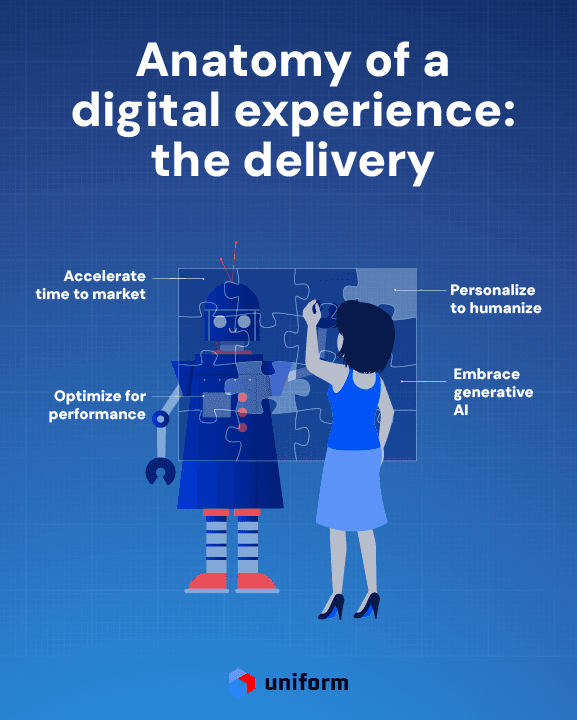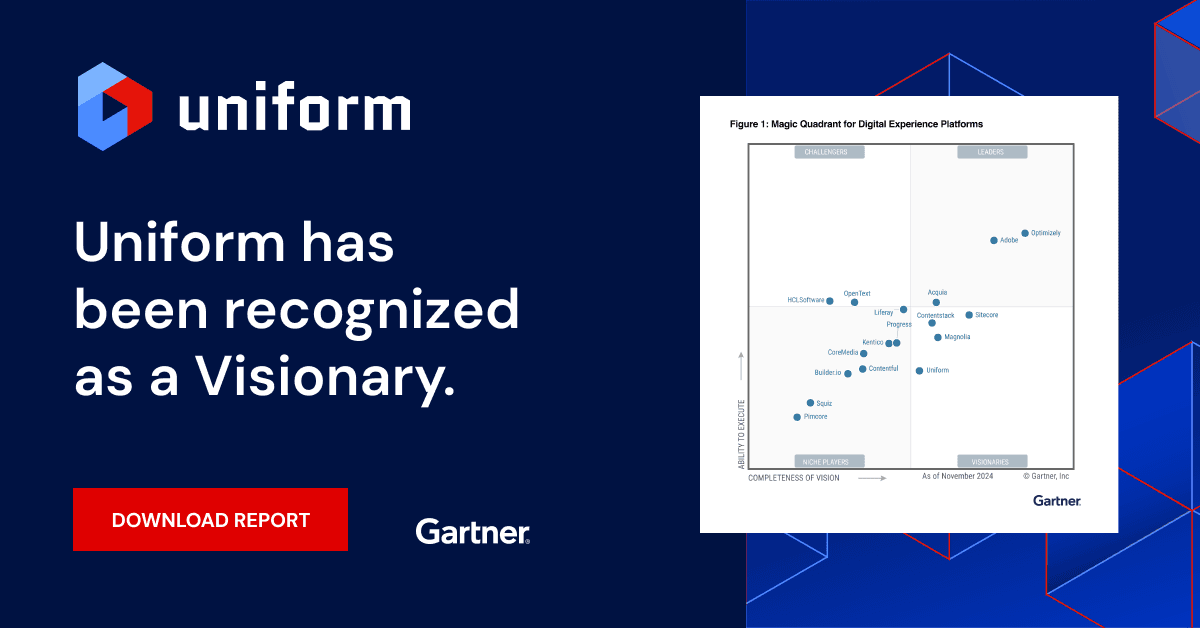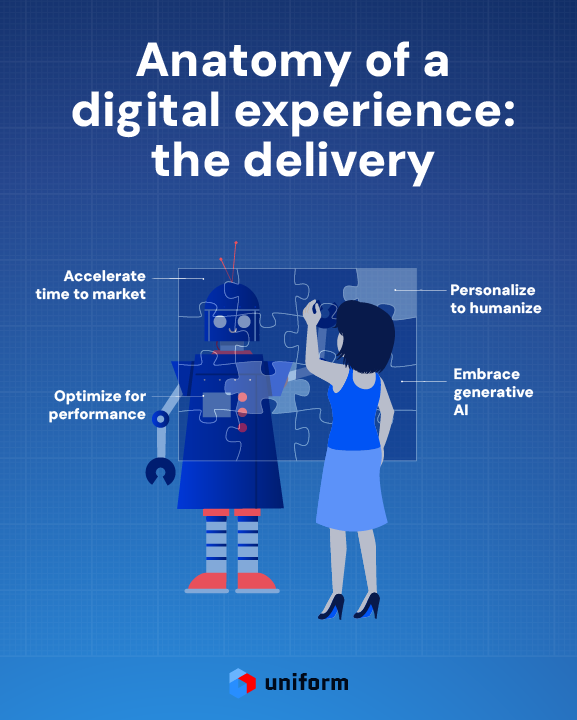Uniform blog/Anatomy of a digital experience part 3: the delivery
Anatomy of a digital experience part 3: the delivery
Anatomy of a digital experience part 3: the delivery
Now that your blueprint and production are dialed in, we want to ensure your omnichannel experiences feel natural and intuitive. With nearly three-fourths of consumers stating they would switch to a competitor after one bad experience, boosting focus and investment in customer experiences to meet evolving market expectations is inevitable.
In this final installment of our three-part series, we highlight in four powerful ways to accelerate, optimize, and humanize digital experiences to transform your online engagements from run-of-the-mill to running the show.

Accelerate time to market
A well-executed digital experience might appear effortless on the surface. However, the reality is that successful campaigns take significant coordination and close collaboration between digital teams.
Despite 75 percent of businesses saying that workflow automation provides a strong competitive advantage, digital production processes are often plagued with redundancies, superfluous steps, and heavy developer involvement. The process of creating a landing page alone can require copy from a writer, images from a designer, build support from a web content manager, and a developer to assemble and publish the content to a web server.
Unnecessary reviews and frustrating bottlenecks prevent marketers—the owners of the digital experience—from controlling when, where, and how digital experiences are published. Moreover, content creators must rely on engineering support, which causes additional delays and, ultimately, a less satisfying customer experience.
Who is the culprit behind these inefficient interdepartmental workflows? Commonly, it’s rigid architecture anchored by a content management system (CMS). To solve these obstacles holistically, companies are opting for experience-first platforms that provide the technological foundation that enables content creation at scale and a visual interface where editing and publishing fall under the purview of marketers.
In effect, a marketer-first platform shortens the path between creation and deployment by leveraging digital production processes that work best for digital teams. With more control over presentation, marketers gain greater autonomy and improved efficiency in priority areas like personalization.
Personalize to humanize
Despite evidence pointing to the benefits of effective personalization, brands still struggle to implement personalized experiences due to insufficient resources, data silos, and outdated technologies. What’s more, research shows nearly 40 percent of brands face challenges when implementing personalization systems in their organization.
Another obstacle for digital teams is accessing and/or leveraging their company’s demographic, behavioral, and other user information to drive large-scale personalization campaigns. Generally, this data is stored in CMSs and other data repository technologies across an enterprise. The inability to apply this data in creation workflows creates friction when attempting to launch at the speed of the market.
How can marketers overcome the challenge of delivering contextualized experiences that convert leads and build customer loyalty? In a front-end experience solution, content, data, and marketing tools–such as personalization–are unified inside a single-browser tab workspace. Instead of switching between multiple windows, downloading and uploading, etc., digital teams have centralized access to content and personalization data in one location, the Visual Workspace, accelerating delivery time.
Marketers can also pull insights from customer surveys, web analytics, and other metrics to create on-brand stories, relevant recommendations, and tailored promos that resonate with customers on a granular level.
Personalized experiences should feel human and foster one-to-one connections that strengthen the relationship between your brand and audience. Constant testing and iteration are critical to staying competitive and producing consistent experiences that effectively leverage customer data.
Optimize for performance
In a world where the majority of readers spend an average of 15 seconds or less on a web page, understanding the motivations of customers and prospects is key to determining what content performs best.
A/B testing helps pinpoint the variations in headlines, teaser text, and even button copy that can increase conversions. By comparing two versions of a landing page—for example, one with a banner image and one without—and serving them to a subset of your users, you’re one step closer to identifying the winning version that should be displayed to your primary audience.
We’ve already mentioned how a multisource experience composer enables marketers to build, customize, and deploy omnichannel experiences in one secure, controlled environment. A/B testing further optimizes this process, providing digital teams with several benefits:
- In addition to better control and autonomy, A/B testing allows for rapid, data-driven decisions based on performance instead of estimates or best-case scenarios.
- Because A/B testing and personalization are native to a unified platform, you can test, tweak, and preview content using real-time data without disrupting the digital experience.
- A modern digital experience management solution comes with pre-built connectors that seamlessly integrate and blend analytics and other tools regardless of where they are in the tech stack.
When incorporating testing into your workflow, it’s important to cultivate a culture of innovation, experimentation, and iteration throughout all digital teams. Establish mechanisms such as social listening, surveys, and feedback forms across your channels to develop hypotheses for A/B tests and validate results. Share these insights with salespeople, who can use this behavioral intelligence to create more memorable interactions with customers one-to-one.
Embrace generative AI
With the right tools and corporate guardrails, generative AI can be incredibly effective in producing fast, quality content in seconds. However, many brands face several barriers when incorporating AI into the content creation and delivery process. Some of these challenges are:
- A lack of AI knowledge and expertise among staff
- Data security and privacy concerns
- Implementation costs
- Vendor fatigue (e.g. How to know which vendor is right for your brand)
In a tech-agnostic platform such as a visual workspace, digital teams can reap the advantages of generative AI, regardless of vendor. Marketers can instantly generate and revise text and images based on the language model approved by the organization and confidently use pre-configured prompts that comply with brand guidelines.
How fast you create content also impacts how far you can scale generative AI, A/B testing, personalization, and other features throughout your experience. This functionality is embedded into every aspect of the visual workspace, allowing for greater control, improved productivity, and faster, unique, next-generation experiences.
Build the perfect digital experience machine
Whether you’re a small retailer or global manufacturer, delivering and maintaining a phenomenal customer experience is contingent on your team’s ability to produce and deliver relevant, timely content by building the perfect digital experience machine.
To provide your customers with consistent, meaningful interactions across every digital touchpoint, consider a front-end presentation solution that integrates future-forward capabilities into a powerful digital experience platform. The visual workspace, a front-end experience solution that connects marketer’s most powerful tools—personalization, A/B testing, AI, and more—to digital content creation, can accelerate your production and slash delivery time to generate quantifiable results.






.png&w=1080&q=90)
.png&w=1080&q=90)
.png&w=1080&q=90)